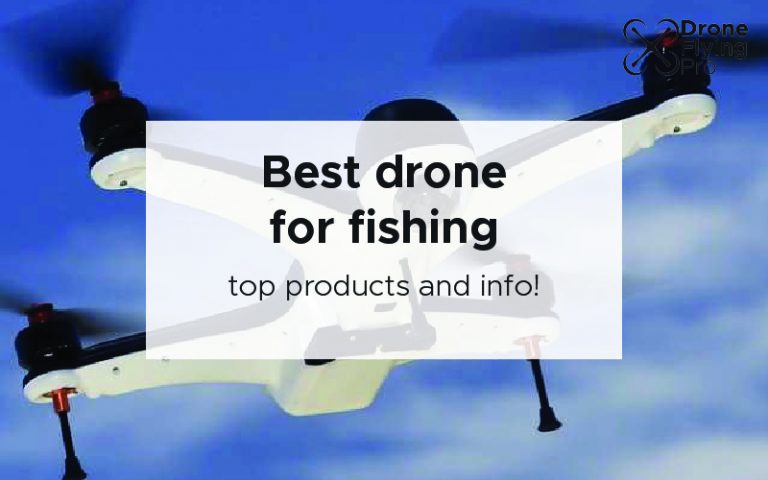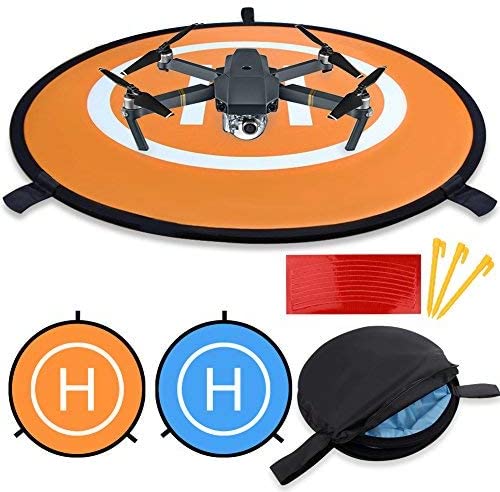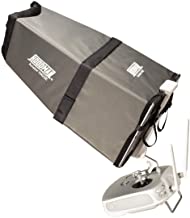Drone fishing is a relatively new activity in the drone world. To come to fruition we needed a commercial, moderately inexpensive, a drone that is capable of carrying bait and weights out over the ocean. It needs to be sturdy, powerful, and not too expensive – so it doesn’t hurt so much if it ends up taking a swim. The worst outcomes from a drone fishing outing! Here we will go through all of the things you should know about drone fishing and how you can choose the best drone for your fishing adventures!
The best drone for fishing is the Gannet pro series. Closely followed by the Poseidon and Sharkan fishing drones. Getting a dedicated drone for fishing is a great option as they are all waterproof and sand proof and most can even land on the water. If, however you have a drone already, you can retrofit the drone with a DIY bait release mechanism with a simple hook attached to the body. There are also many third-party bait release mechanisms for all of the most popular DJI drones. That way to can go drone fishing for a fraction of the cost of a dedicated fishing drone.
In a hurry? What drone is best for fishing?
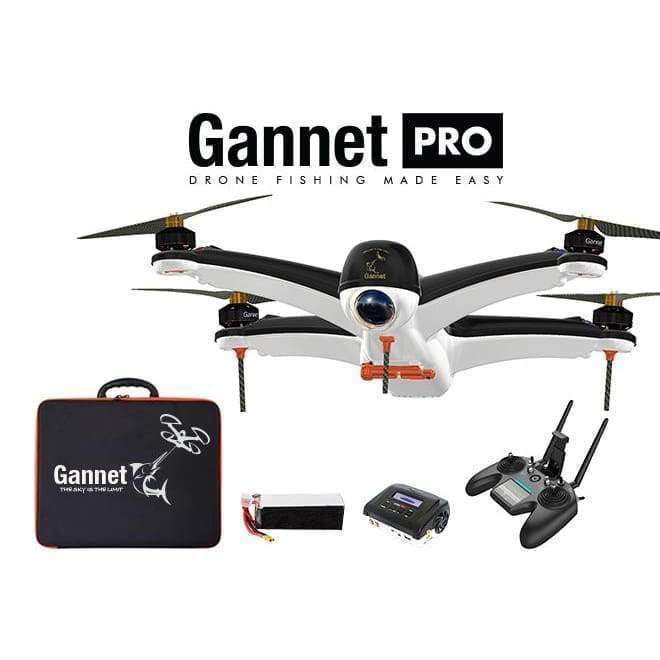
The gannet drone has been designed as a lightweight but powerful delivery drone. It was designed to carry lifevests for search and rescue operations and was expanded to include other items – such as fishing equipment. The Gannet drone is designed to fly forward better than any other direction – cutting through the wind and getting your bait out faster! When hovering in place, the elongated body is slanting backwards this so that when the body is horizontal the drone is already travelling forward at speed. This results in the smallest possible frontal area cutting through the air conserving battery power as much as possible making these some of the most power-efficient drones on the market.
The color scheme is specifically to match nature – light on the bottom and dark on top. This allows the Gannet to fit into its natural environment perfectly. The black and white are also designed so that it stands out against the blue of the sky – making it easy to spot from shore. Here are some of it’s features:
- Fully waterproof
- Up to 2.5 kg payload
- Water and Sandproof so you can land on the beach with confidence
- LCD display for drone telemetry, battery, and GPS status, use with or without a smartphone (camera is extra)
- Fully sealed electronics, preventing corrosion of electronics, despite needing uninhibited barometric pressure sensing
- Failsafe electro-mechanical payload release that can be mechanically or electrically activated
- Expandable with the option to add external long-endurance batteries and custom payload bays
- Bright onboard lights for easy night navigation
This drone has it all for your next fishing adventure!
Pros
+ Water and Sandproof
+ 2.5 kg payload
+ Rugged design
Cons
~ Camera is an optional extra
How much does a fishing drone cost?
Fishing drone models vary wildly in cost and quality. All have very distinctive features and advantages over their competitors. Each new feature comes at an additional cost. Fishing drones are a little more expensive than the common drone because they tend to carry extra weight and are also able to survive the harsh conditions of the ocean – at least the dedicated fishing drone can!
Here are the most popular drones and their pricing at the time of writing (or updating) this post.
| Drone | Price (USD) | Link to Product |
|---|---|---|
| Swellpro Waterproof Splash Drone | 1,399 | Link to Amazon |
| Gannet Pro Drone | 1,299 | Link to Website |
| Gannet Pro Plus Drone | 1,699 | Link to Website |
| Poseidon Pro Waterproof Fishing Drone | 1,999 | Link to Website |
| Sharkan fishing drone | 1,023 | Link to Website |
| DJI Mavic 2 (needs adaptor) | 1,599 | Link to Amazon |
| DJI Phantom (needs adaptor) | 1,599 | Link to Amazon |
These prices may seem a little high for the “simple” act of dropping some bait out into the ocean. But there are plenty of great reasons that you may consider buying a drone. Also, by the way, the price of the drone is far under what buying a boat would cost you to get you to the same fishing locations.
Here are the best reasons to fish using a drone:
Why fish with a drone?
To the die hard angler, having a drone way just seem like a silly gadget! On the contrary, a drone opens up a whole new way to fish from the shore or from a boat and here are the reasons that drones will open up your fishing world!
Scout new angling spots
Taking a drone with a camera on the front isn’t just for dropping the bait. You may want to take the drone out before you have even settled on a fishing location to scan the beach or coastline for the best fishing locations given the conditions on the day.
You may even find a hidden spot in a familiar fishing location that you hadn’t seen before. Using the drone as a simple scouting device may be the only reason you need to take it out on your next fishing trip. However, the benefits do not stop there!
Find the schools of fish
Having a drone fitted with a camera gives you a bird’s eye view of the world. And just like a bird, you will be able to spot the schools of bait fish or other fish as you fly above the water. It is much easier to see into the water from directly above ti so you’ll be able to spot the bait fish with no issue or glare from the ocean.
Using the camera mounted on the drone you’ll quickly be able to identify the perfect spot for dropping the bait. In this YouTube video these fishermen are able to find a ball of bait fish that tuna are attacking and drop their hook right into the mix – it’s a pretty incredible sight to watch:
Massive casting distance
I remember when I first saw a beach caster rod. I was only small and it just seemed like one of the biggest things I’d ever seen. They are big for reasons like leverage for casting, strength for choppy seas. There is a certain pride that my dad took in casting into the surf as far as the eye could see (the little weight at least). It seemed like quite the skill to be able to get the bait such as distance. With a drone that skill is no longer as vital!
When you are drone fishing you no longer have to worry about casting out into a certain spot – past rocks or into a and bar – the drone will simply take the bait out for you! With a drone, you can literally get as far out as the amount of line you have on your spool! All of that without having to get your feet wet or into a boat!
Drones are not bound by any surf conditions
Unlike a boat, kayak or pontoon a drone does not have to worry about surf conditions or changing tides. You can simply fly he drone up and out into the surf and start fishing.
The only thing that will stop a drone in its tracks is a really high wind or gusts. The rule of thumb is you can fly in wind speeds up to two-thirds of the drone maximum cruising velocity. That will mean that you will be able to combat the wind and have enough power to get back.
TOP TIP: fly out against the wind is you can! You don’t want to run out of battery as you are flying back. There’s nothing sadder than watching a drone slowly lowering itself into the water.
Less expensive than a boat
Even though the price a drone is quite high compared to other fishing accessories that you may be able to buy – a drone is significantly lower in cost than a boat! A drone will allow you to do all of the things that boat fishing allows you to do – apart from the sea air blowing through your hair – but at a fraction of the price and without the sea sickness too!
A drone won’t scare away fish
Some of the best fishing I have done is from a boat. But there’s a couple of downsides to fishing from a boat. One of them is that the sound of the motors could scare away some species of fish. The great thing about a drone is that they cause no disturbance or noise in the water and it is therefore very unlikely that the drone will be able to scare away andy fish.
Using the camera, you can position the drone straight above the fish and they are none the wiser. Ready for you to drop in the bait!
Can you fish with a drone?
When I first heard about drone fishing I imagined a drone with a fishing line on it hovering above the water with a line in and then dragging the fish back to shore. The reality is that every fish would quickly over power a drone. Instead you use the drone to “cast” the line out as far as you want and drop it in the water. The drone can return to home and you can reel in the fish!
There are two ways that you can access this awesome way of fishing:
- You can buy a drone that is specifically designed for drone fishing. They tend to be waterproof, able to carry a heavy load, and also have a mechanism by which the bait can be released.
- You can use a photography drone (like the DJI Mavic or Phantom Series) and add an attachment to allow for the release of a fishing line after it has been sent out over the water. This can be as simple as a bit of wire or a third-party accessory that is purchased and attached to the drone.
Either option is capable for bringing the benefits of drone fishing your your next trip. There are advantages and disadvantages to both options and we will discuss those in the next sections. Both of these two options rely on the basic mechanism of dropping a line over the water once you reach a certain distance from shore. But how they do it varies – let’s take a look at that.
How do you drop a fishing line from a drone?
Dropping the bait on top of the fish is the most important feature that a drone should perform. You need a mechanism that is sturdy and reliable. so that you can trust that the bait will be dropped exactly where you want it to fall! The best way to be sure of this is to by a drone that is a dedicated fishing drone.
Dedicated fishing drone
A fishing drone will come with the mechanism preinstalled and will also have a dedicated button on the controller so you know exactly where and when the bait will be dropped. If you have the money and the need for a dedicated fishing drone this is the best option for you.
Below is the Gannet pro drone. You can see the black release mechanism on the belly of the drone.
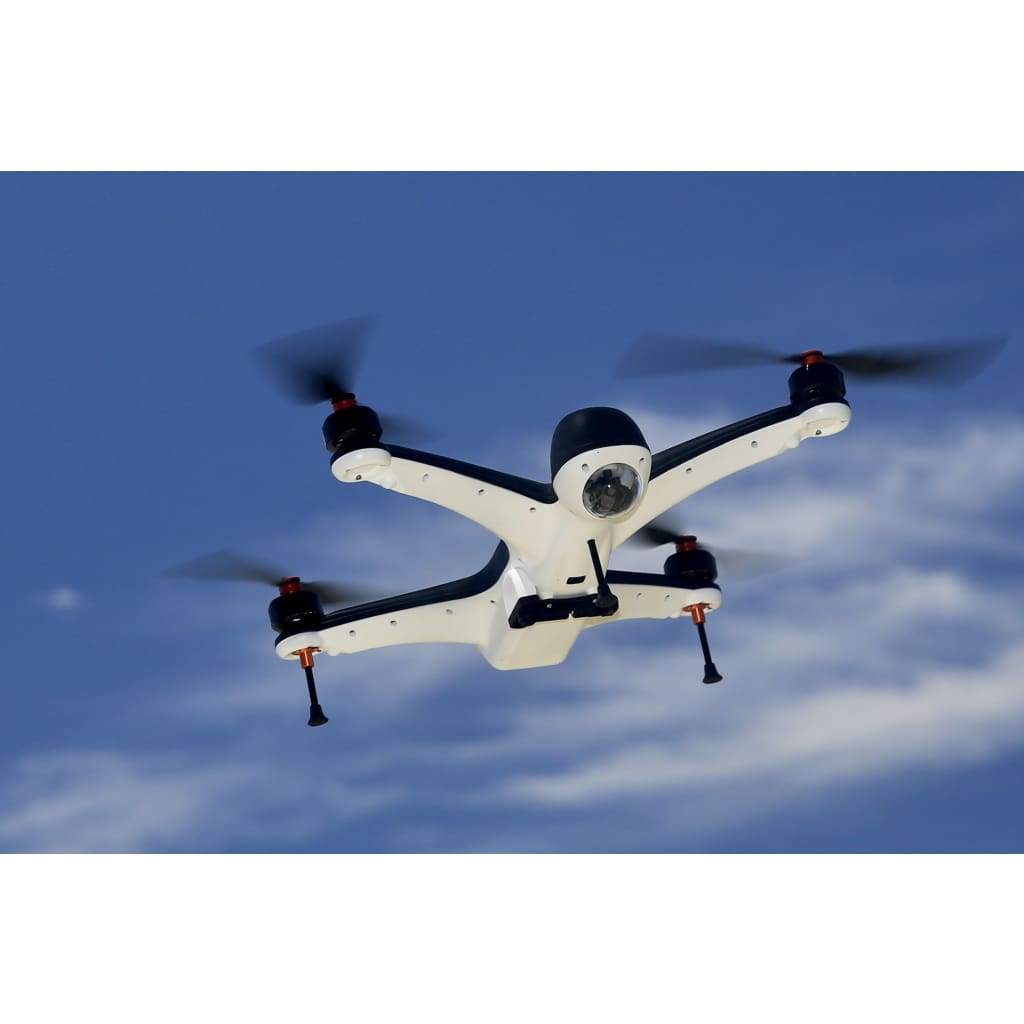
If you don’t feel like spending over $1,000 on a dedicated drone for your fishing but you have a photography drone sat around at home and you want to give it another job! There’s a way that you can get the same line dropping features for a fraction of the price of a dedicated fishing drone!
The DIY way!
The DIY method involves using a drone that you already have. This could be a DJI drone from the Mavic, Phantom, or inspire series and adding a little hook to the bottom of the drone so that it can carry your bait out into the ocean. In the following video, you fisherman is able to use a coat hanger hook and a couple of zip ties to create his dropping system:
A DIY method works like this:
- Attach a forward facing hook on the bottom of the drone (wire and cable ties)
- Tie a loop in your line above the tackle and bait.
- Place the loop on the hook of the drone
- Fly forward with your reel in free spool
- Once you get to the place you want to drop the bait turn the drone around to the open par of the hook is facing the rod.
- Lock of the reel and fly backwards – causing the loop to be pulled off the hook.
- The bait will fall into the ocean and you can fly the drone back to the shore or you can press the return to home button to do it automatically, if your drone has that feature.
The last way of dropping a fishing line is to use a drone that you already have and buy a third-party adapter to hold and release the bait.
Buy an adapter for your drone
There are an increasing number of attachments for common commercial photography drones that can carry and drop bait. Here are some of the most popular:
| Product | Link |
|---|---|
| Gannet release systems | Website link |
| O’woda Mavic 2 Drone Airdropper Clip | Amazon link |
| Top Race Drone Clip Remote Control Object Launcher | Amazon Link |
| Sky Rigger | Website Link |
You have to make sure that with all of these gadgets that they are compatible with the model of drone that you are using and that they are fully tested before heading out into the ocean! A couple of dry runs on land will make sure that you won’t have to suffer the pain of watching your drone swimming because of a silly technical error.
Should you decide to make the jump into the dedicated fishing drone world – here are the top fishing drones you should consider:
Top fishing drones
This is a new and rapidly evolving area of drone technology. But here’s a rundown on the best of the best. I chose drones that I would feel confident sending out over the water!
Gannet pro fishing drone

The gannet drone has been designed as a lightweight but powerful delivery drone. It was designed to carry lifevests for search and rescue operations and was expanded to include other items – such as fishing equipment. The Gannet drone is designed to fly forward better than any other direction – cutting through the wind and getting your bait out faster! When hovering in place, the elongated body is slanting backwards this so that when the body is horizontal the drone is already travelling forward at speed. This results in the smallest possible frontal area cutting through the air conserving battery power as much as possible making these some of the most power-efficient drones on the market.
The color scheme is specifically to match nature – light on the bottom and dark on top. This allows the Gannet to fit into its natural environment perfectly. The black and white are also designed so that it stands out against the blue of the sky – making it easy to spot from shore. Here are some of it’s features:
- Fully waterproof
- Up to 2.5 kg payload
- Water and Sandproof so you can land on the beach with confidence
- LCD display for drone telemetry, battery, and GPS status, use with or without a smartphone (camera is extra)
- Fully sealed electronics, preventing corrosion of electronics, despite needing uninhibited barometric pressure sensing
- Failsafe electro-mechanical payload release that can be mechanically or electrically activated
- Expandable with the option to add external long-endurance batteries and custom payload bays
- Bright onboard lights for easy night navigation
This drone has it all for your next fishing adventure!
Pros
+ Water and Sandproof
+ 2.5 kg payload
+ Rugged design
Cons
~ Camera is an optional extra
Poseidon fishing drone
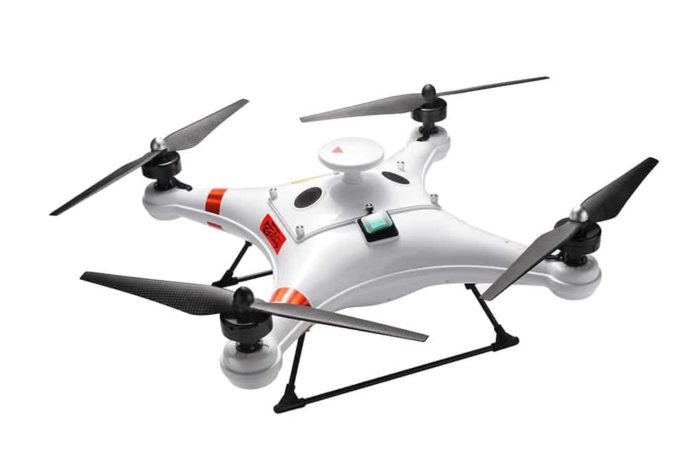
The Poseidon fishing drone has been specially designed and constructed for fishing. From the corrosion-proof design, 32 minute flight time, and a Beaufort windproof rating of up to 6 – it is one of the best drones for fishing! They have thought of nearly everything! Here are a few of its features:
- Constructed utilizing anti-corrosive materials.
- Has been engineered to a very high IP67 Dust and Waterproof rating. IP stands for Ingress Protection -6 is the solid ingress protection rating and 7 is the liquid ingress protection rating. Tested and proven waterproof drone.
- Motors, bait release mechanism, and camera are all waterproof and made from anti-corrosive materials
- High rated wind capacity
- ABS plastic for impact resistance
Pros
+ Water and Dustproof
+ Anti-corrosion protection
+ High wind capacity
Cons
~ Not a very attractive drone
~ a little bulkier than other drones
Sharkan fishing drones
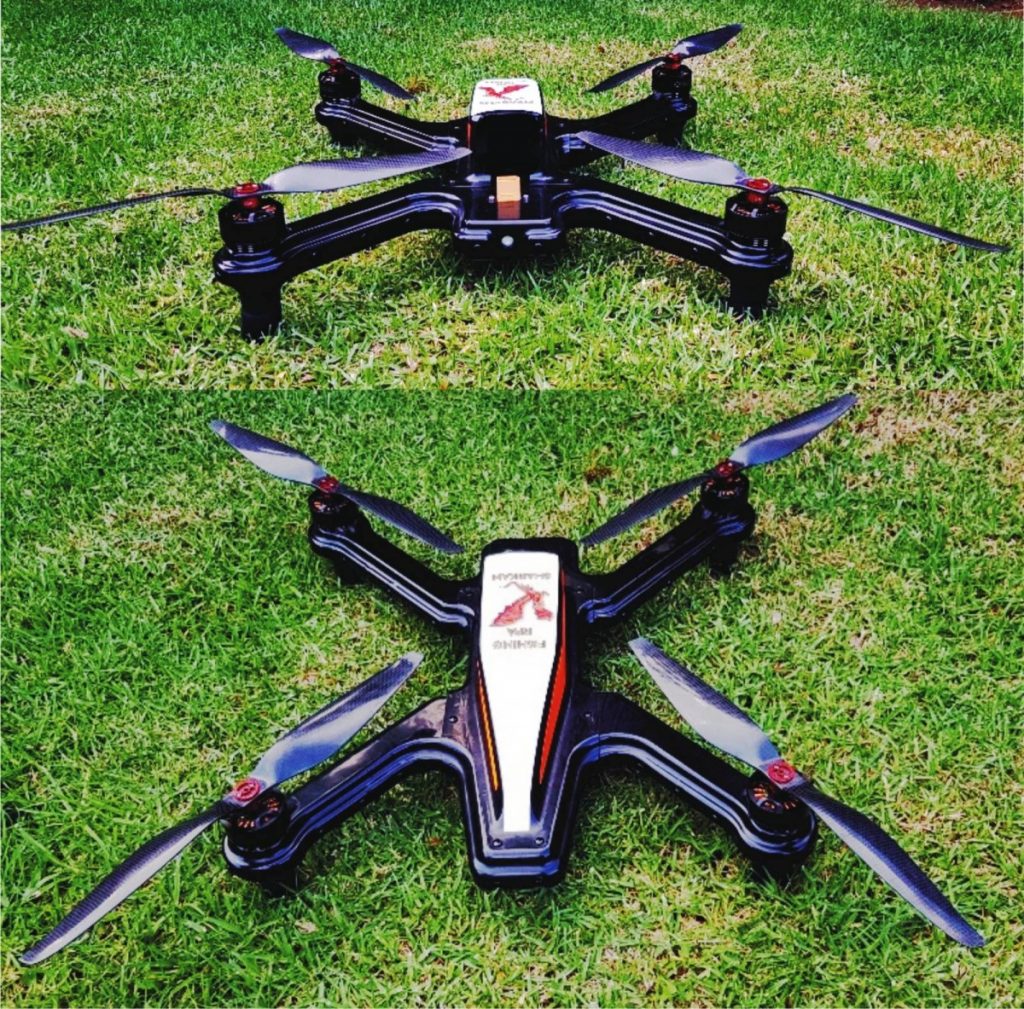
The sharkan fishing drones come in three series. They vary based on how much they can carry, how many things they can drop (up to 15 drops), and also the class of line that they are able to carry. Here are a few of the features of the sharkan range:
| M4 series | M6 series | E series |
|---|---|---|
| Up to 5 drops of 750gr payload at 200m (Tackle and weather dependant) on 6000mah and 3 on 5000mah | Up to 15 drops of 500gr payload at 200m (Tackle and weather dependant) on 6000mah and 10 on 5000mah | Up to 3 drops of 1.2kg payload at 400m (Tackle and weather dependent) |
| 20-50lbs Line Class | 30-80lbs Line Class | 50-100lbs Line Class |
| Drone/Quick Release, Carbon Propellers/Transmitter/Battery Reader/Smart Charger /Bait Release1 x 4S 5000mAh Battery | Drone/Quick Release, Carbon Propellers/Transmitter/Battery Reader/Smart Charger /Bait Release1 x 4S 5000mAh Battery | Drone/Quick Release, Carbon Propellers/Transmitter/Battery Reader/Smart Charger /Bait Release1 x 6S 5000mAh Battery |
All drones are fully water proof and include internal flotation.
Pros
+ Multiple drops
+ Fully waterproof
+ High wind capacity
Cons
~ No Camera
Swellpro Waterproof Splash Drone
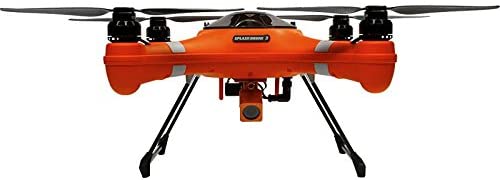
The Swellpro waterproof splash drone has been made with drone fishing in mind. It has a maximum of a 1 kg loading capacity, a 1 km flying range, and a 20 minute flying time – everything you need to deploy bait into the ocean safely and quickly. Here are a few of the other features that make this a drone that you should consider:
- 100% waterproof and saltwater friendly
- Fishing line release mechanism with HD camera
- Precise bait dropping with all in one remote controller and live video monitor
- Long flight range and decent flight time
- Auto return to home and auto land
Interestingly, this drone is able to land on the water and stream back the live underwater footage from the camera. There is no other drone on this list that can do that. I assume that you can’t do such a thing in high surf.
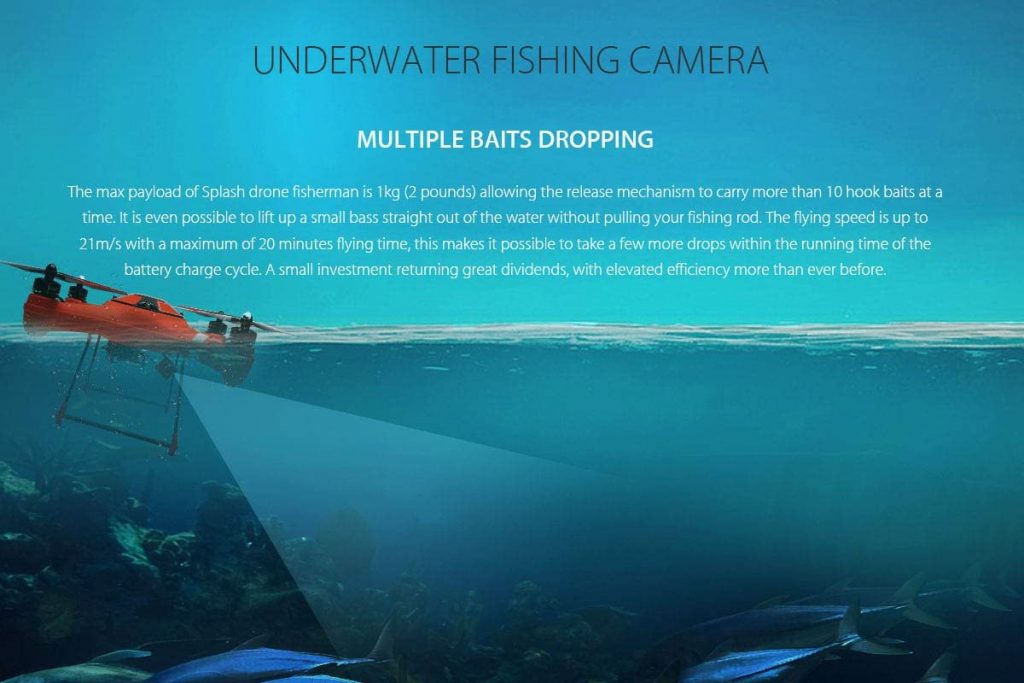
Pros
+ No smartphone required
+ Fully waterproof
+ Auto land
Cons
~ Lower flight time than others
DJI fishing drones
The DJI range does not include a dedicated fishing drone. Rather, the drones are able to be fitted with release mechanisms and you can find one for pretty much every one of the DJI range that would be capable of carrying anything. Over on this article I listed all of the DJI drones and the maximum amount that they can lift. Here is a quick summary of the drons that I looked into for the article:
Drone payload comparison
It can be hard to know exactly what a drone can lift in the wild vs what the manufacturer says. Here is a comparison of some of the most popular commercial drones alongside drones that are manufactured to lift heavy things! You’ll be surprised exactly how much some of the smaller drones can lift!
| Drone | Maximum Payload | Source of information |
|---|---|---|
| DJI Matrice 600 Pro | 6 kg | Official Website |
| Freefly Systems ALTA 8 | 12 kg | Official Website |
| DJI Agras MG-1 | 10 kg | Official Website |
| PD6B-AW-ARM | 20 kg | Official Website |
| DJI Mavic Mini | 181 g | YouTube experiment |
| DJI Mavic Air | 331 g | YouTube experiment |
| DJI Mavic 2 Pro | 531 g | YouTube experiment |
| DJI Phantom 3 | 1.1 kg | YouTube Experiment |
| DJI Phantom 4 | 1.1 kg | YouTube Experiment |
| DJI Spark | 65 g | YouTube Experiment |
| VALKYRIE HEAVY PRO | 30 kg | Official YouTube video |
Clearly, the drones that are designed to pick stuff up, like the VALKYRIE HEAVY PRO and Freefly Systems ALTA 8, can pick up the most. However, even the commercial drones like the DJI Phantom series can pick up quite a large object.
Essentially, you need to find a third-party release mechanism for the drone that you currently have. There are plenty available and the common ones are listed above in this article.
Once you have selected your drone, or modified the drone that you want to use as your fishing drone there is a load of other accessories for your drone fishing kit that will make your drone fishing outing perfect!
Drone fishing kit
The perfect drone fishing kit not only consists of a drone that you are confident will return when you send it out over the ocean and do its job the same every time but also a series of accessories that just make the flying and piloting experience more enjoyable. Here are the accessors that every drone fisherman should have!
Landing pad
A drone landing pad is a large fold-able fabric circle that protects the drone and the propellers as it is taking off and landing.
When you are beach fishing and you are taking off from the sand the propellers can kit up a lot of debris. If your drone is sand proof like the dedicated fishing drones mentioned above then you will have no issues with sand getting into the body of the drone but it could still damage the propellers. So, no matter what drone you have it is advisable to take off and land on a landing pad. They are inexpensive and can save you a load of trouble!
Hood for screen
If you are lucky enough to live in a warm and sunny climate, the sun could become a massive pain as in washes out your screen.
A screen hood will allow you to see the screen clearly at all times. This is important because you will decide where to drop the bait based on the conditions you observe from above. The hood will make sure that no matter what the conditions. You’ll give your bait the best chance of finding a fish!
Polar filters for camera
If your fishing drone has a camera you will need to get neutral density filters (NDFs) for the front of your camera lens. Neutral Density Filters reduce the amount of light entering your camera without affecting the color tones. They are like sunglasses for your camera. Start with an ND16 filter when flying your drone during daylight to see if that gives you the optimum clarity while flying.
You will need to buy packs that are specifically made for your drone model. You’d hate for them to come off during a flight. They also need to be well fitted and quality construction so that you don’t get any light leakage into the camera causing starring and other distracting features!
Powerbank for batteries
When you are out on the beach the last thing you want if for your drone to run out of battery. Find a good external battery charger that you can trust to charge up your drone batteries while on the sand. They may be a little heavy to transport the fishing spot but will ensure hours and hours of drone fishing fun!
Lanyard
When you are drone fishing there are a number of things that you need to do – almost simultaneously. Having a good lanyard for your remote means that you can multitask with ease. Also, while the drone is auto-landing you can take full control of the rod without having to put the controller down for the final bits of the landing.
Click here to find the best lanyards on the Amazon marketplace.
